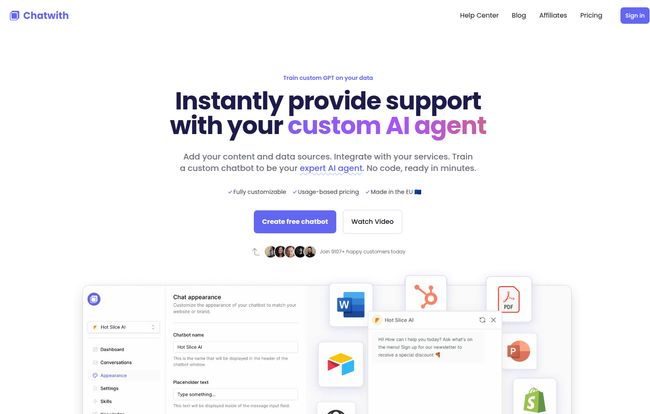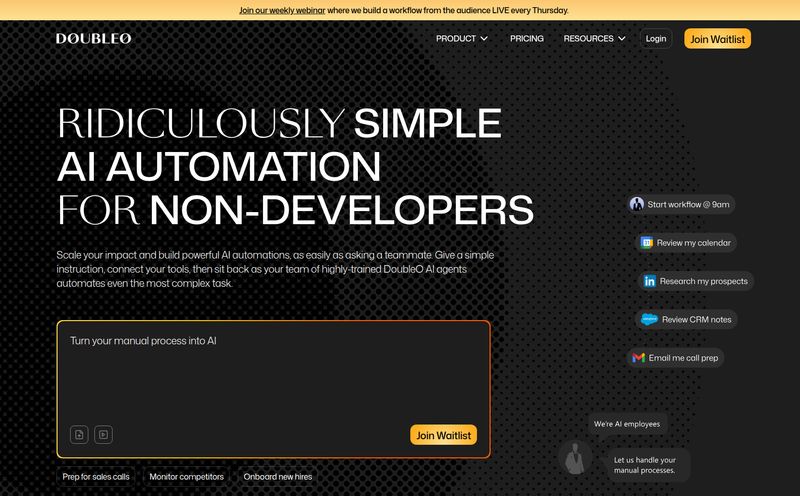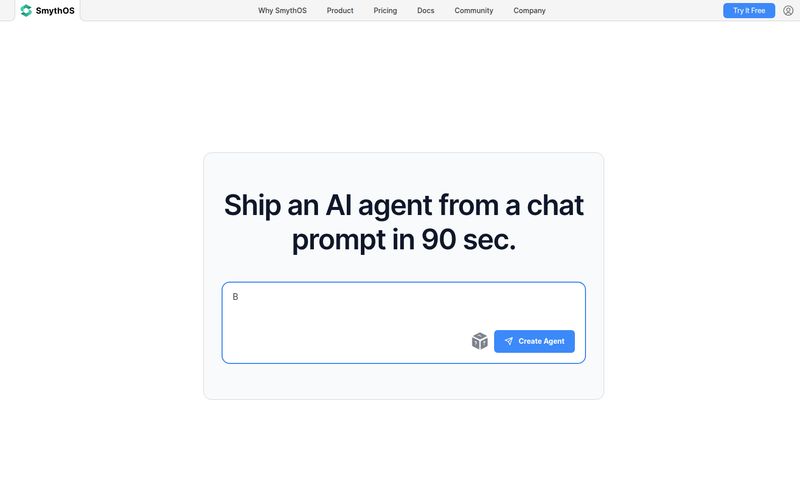That little chat bubble in the corner of a website? It can be your best friend or your worst enemy. For years, we've dealt with clunky, robotic chatbots that feel like navigating an automated phone menu from hell. You know the ones. They can't answer a simple question outside their rigid script and usually end with a frustrating, "I'm sorry, I didn't understand that."
I've spent more time than I'd like to admit fielding the same five questions over and over again for my own projects. It's a time-suck. It drains your energy. And while you're answering "Where's my order?" for the tenth time, a potential high-value lead is getting bored and clicking away. We’ve all been there.
So when the new wave of AI hit, driven by models like ChatGPT, I got excited. Not for the party tricks, but for the practical applications. Could we finally have a chatbot that actually helps? One that doesn't require a team of developers and a six-figure budget? I've been keeping my eye on the no-code tools popping up, and one that recently caught my attention is Chatwith. I decided to take a proper look.
What Exactly is Chatwith, Anyway?
Alright, so what’s the deal? Chatwith isn't just another generic chatbot. Think of it less as a pre-programmed robot and more like a new employee you can train yourself. Its main hook is that you build a custom AI chatbot by feeding it your own data.
We're talking about pointing it to your website, uploading your product manuals, your FAQs, your knowledge base articles, even random text files. It ingests all that information and builds its own little brain, specifically for your business. So when a customer asks a question, it's not guessing or pulling from the vast, sometimes weird, expanse of the internet. It's pulling the answer directly from the source material you provided. It's your information, delivered through an intelligent interface.

Visit Chatwith
The goal here is pretty clear: automate a huge chunk of customer support. The site claims it can handle up to 80% of questions automatically. That's a bold claim, but even if it handles half of that, we're talking about a massive reduction in workload for human support teams. More time for the complex issues, and less time on the repetitive stuff.
The Features That Actually Matter
A features list can be boring, so let's skip the bullet points and talk about what really makes a difference here. I've seen a million platforms with a million features, but only a few ever really change the game.
It's All About Your Data
This is the core of it. The customization. A generic chatbot might know what a "refund policy" is in general terms. A Chatwith bot knows your specific refund policy, down to the 14-day return window and the fact that you don't accept returns on final sale items. Why? Because you fed it the document that says so. This contextual awareness is what separates a useful tool from a digital paperweight. It can even perform what they call "AI Actions" to check inventory or generate documents on the fly, moving beyond simple Q&A.
Plays Nicely With Your Entire Tech Stack
A tool that lives on an island is a useless tool. What got me interested in Chatwith is its claim of over 6,000 app integrations, mostly through Zapier. This is huge. It means you can connect your chatbot to almost anything. When a chatbot captures a lead, you can have it automatically sent to your CRM like HubSpot or your email list on Mailchimp. When a complex query comes in, it could create a ticket in Slack or Jira for a human to review. It turns the chatbot from a simple Q&A box into a central hub for business automation. That's powerful stuff.
No PhD in Computer Science Required
I've always been a bit skeptical of "no-code" promises, as they sometimes mean "no-code, but you'll need to understand a lot of complex logic." From what I can see, Chatwith seems to be genuinely built for the non-developer. The process is straightforward: create a bot, give it your data sources (website links, files), and embed it on your site with a snippet of code. The interface is clean. For marketers, solopreneurs, and small business owners who wear a dozen hats, this accessibility is probably the most important feature of all.
Speaking Your Customer's Language (Literally)
Supporting over 95 languages is no small feat. If you have any sort of international audience, this is a massive win. You don't need separate bots or complex configurations. The AI handles the translation, allowing you to offer support to customers in their native language. It's a simple way to make a global customer base feel seen and valued.
Let's Talk Money: The Chatwith Pricing Breakdown
Okay, the all-important question. What's this going to cost? The pricing is a tiered, usage-based model, which is pretty common for AI services. Let's break it down.
| Plan | Price | Who It's For |
|---|---|---|
| Hobby | $19 /month | The curious individual, blogger, or solopreneur. A great way to test the waters with 1,000 messages and one chatbot. You'll have to live with the Chatwith branding, but for the price, it's a solid entry point. |
| Standard | $99 /month | This feels like the sweet spot for most small-to-medium businesses. You get a much higher message credit (10,000), 3 chatbots, and most importantly, you can remove the branding. This is crucial for a professional look. Unlimited team members is a nice touch, too. |
| Business | $399 /month | This is for larger operations or agencies. The volume is significantly higher (40,000 messages), but the key features are the pro-level tools: using your own OpenAI API keys (which can be a huge cost-saver at scale) and full whitelabel capabilities. |
All plans come with a 14-day free trial, so you can poke around before committing. It's also worth noting that if you go over your message or training character limits, you can purchase add-ons. It’s a true pay-as-you-grow model.
My Honest Take: The Good and The Not-So-Good
No tool is perfect. After going through everything, here's my genuine perspective. The biggest advantage is obviously the ability to create a chatbot that is a true expert on your business. That is a paradigm shift from the old rule-based bots. The no-code approach and the insane number of integrations mean you can plug this directly into your existing workflows without hiring a developer. I really like that.
On the flip side, the effectiveness of the whole system hinges entirely on the quality of your training data. If your website is a mess and your FAQ documents are outdated, your chatbot will be a mess and outdated. Garbage in, garbage out. It requires an upfront effort to collate and clean up your knowledge base. Also, some might not love the usage-based pricing. While it's fair, it can lead to unpredictable costs if you have a sudden spike in traffic. You just have to be mindful of your usage, especially on the lower-tier plans.
Who Is Chatwith Really For?
I see a few clear winners here.
- E-commerce Stores: Imagine a bot that can answer questions about shipping, returns, product materials, and even check inventory in real-time. This is a huge conversion-booster.
- SaaS Companies: For handling those Tier 1 support questions—"How do I reset my password?" or "How does your billing work?"—freeing up human agents for the tricky technical problems.
- Content Creators & Bloggers: You could train a bot on all your articles, allowing readers to ask questions and get answers sourced directly from your content. A fantastic engagement tool.
- Digital Agencies: The Business plan is practically built for agencies who want to offer custom chatbot solutions to their clients without building everything from scratch.
Frequently Asked Questions about Chatwith
- What exactly is Chatwith?
- It's a platform that lets you build a custom AI chatbot using your own website content and files. It's designed to answer customer questions automatically, without you needing to write any code.
- Do I need to know how to code to use it?
- Nope. It's a "no-code" tool. The setup process involves providing links and uploading files, then copying a small piece of code to your website. It's designed for marketers and business owners, not just developers.
- What kind of data can I train it on?
- You can train it by scraping a website, providing specific URLs, uploading files (like PDFs, DOCX, TXT), or just pasting in raw text. The more relevant, high-quality information you provide, the smarter your chatbot will be.
- Can I remove the "Powered by Chatwith" branding?
- Yes, but you need to be on the Standard plan ($99/month) or higher. The Hobby plan includes the branding.
- Is there a free trial?
- Yes, the Hobby and Standard plans both offer a 14-day free trial so you can test out the features and see if it's a good fit for your site before paying anything.
- What happens if I go over my monthly message limit?
- The platform offers add-ons. You can purchase extra message credits or additional training characters if you exceed the limits of your base plan. This keeps your bot running without interruption.
The Final Word
So, is Chatwith the magic bullet for all your customer support woes? Probably not. No tool is. But is it a genuinely powerful, accessible, and smart piece of kit that could drastically reduce your support burden and improve your user experience? Absolutely.
For me, the shift from generic, scripted bots to trainable AI assistants is one of the most practical applications of this new technology I've seen. Tools like Chatwith are putting that power into the hands of regular business owners. It’s not about replacing humans, but about augmenting them—letting the AI handle the noise so the people can focus on what matters. And in my book, that's a pretty big win.



